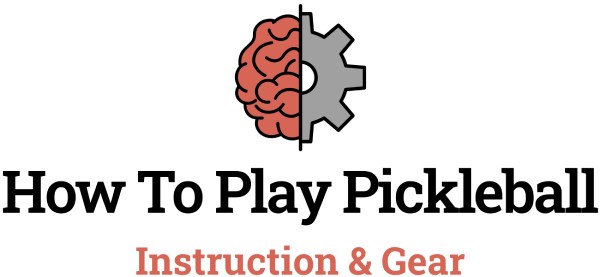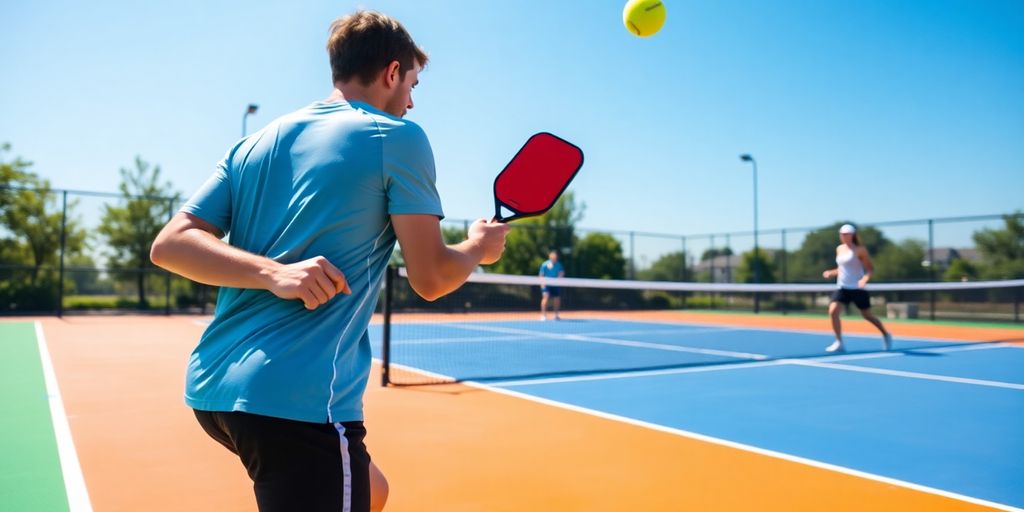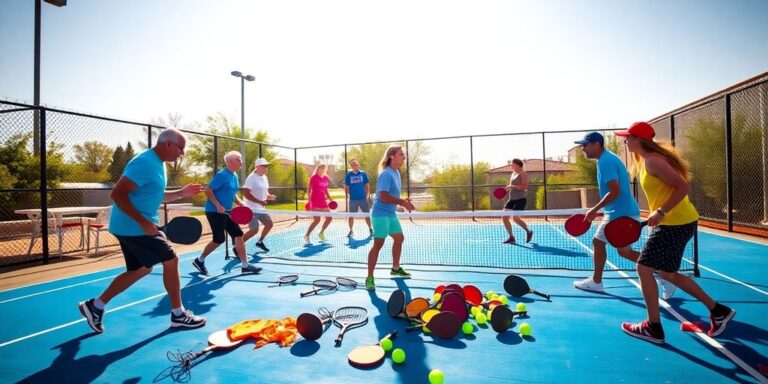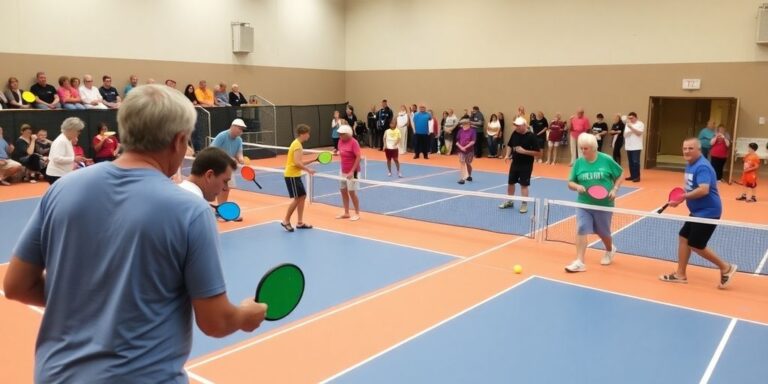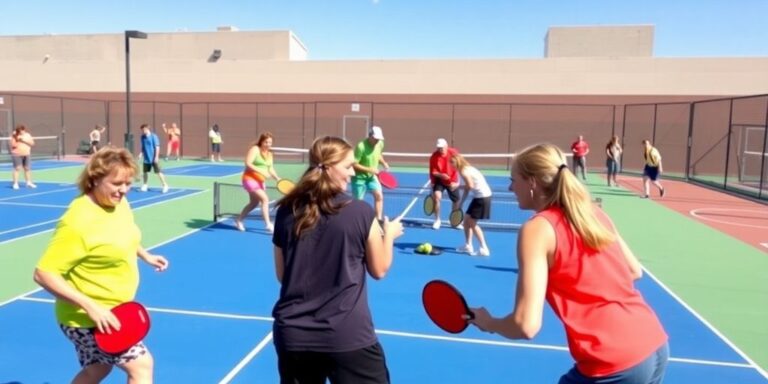Pickleball singles is a fast-paced game that takes elements from tennis, badminton, and table tennis. It’s not just about hitting the ball back and forth; it’s about understanding the rules and using strategies to outsmart your opponent. This guide will walk you through everything you need to know about pickleball singles rules for 2025, from the basic court setup to advanced techniques.
Key Takeaways
- Pickleball singles is a unique blend of various racket sports, requiring both skill and strategy.
- Understanding the layout of the court, including the non-volley zone, is crucial for effective play.
- The serve is a key component, with specific rules that can influence the outcome of the game.
- Scoring in singles follows a distinct system where only the server can score points.
- Physical fitness plays a significant role in singles, as players cover the entire court.
Understanding the Basics of Pickleball Singles Rules
Court Dimensions and Layout
In singles pickleball, the court dimensions remain the same as in doubles, measuring 20 feet wide and 44 feet long. The court is split into two equal halves by a net that stands 36 inches tall at the sidelines and 34 inches high at the center. Each side of the court includes a non-volley zone, commonly known as "the kitchen," which extends 7 feet from the net. This setup demands agility and quick reflexes, as players cover the entire court, making singles a more intense workout.
The Importance of the Non-Volley Zone
The non-volley zone or "kitchen" is a unique aspect of pickleball, crucial for maintaining fair play. Players must not volley the ball while standing in this area. This rule prevents players from dominating the net with aggressive volleys, ensuring a balanced game. The ball must bounce before being hit in this zone, adding a layer of strategy to the game. Mastering play around the kitchen can make or break your singles game.
Basic Serving Rules
Serving in singles pickleball has its own set of rules to ensure consistency and fairness. The serve must be executed underhand, with the paddle making contact with the ball below waist level. The server’s arm should move in an upward arc, and both feet must stay behind the baseline until the ball is served. The serve must land in the diagonal service court. If it doesn’t, it’s considered a fault. Understanding these serving rules is essential for gaining an advantage in singles play.
Mastering the Serve in Pickleball Singles
Serving Techniques and Tips
The serve in pickleball singles is like the opening move in chess. It’s all about setting the stage for what comes next. A solid serve can give you the edge right from the start. In singles, you have to serve diagonally, making sure it lands in the opposite service court. Here’s the kicker: it must be underhand. No fancy overhead swings like in tennis. The paddle should move in an upward arc, and contact with the ball should be below waist level. And don’t forget, both feet need to stay behind the baseline when you serve, or it’s a fault.
- Aim for your opponent’s weaker side, usually the backhand.
- Mix up your serves to keep them guessing.
- Practice placing your serves deep in the court to push them back.
Common Serving Faults
Even the best players slip up sometimes. Here are a few serving faults to watch out for:
- Foot Faults: Stepping on or over the baseline before hitting the ball.
- Incorrect Placement: Not landing the serve in the right service court.
- High Paddle Contact: Hitting the ball above waist level.
These mistakes can cost you points, so it’s crucial to practice and be mindful of your form.
The Role of the Serve in Scoring
In singles pickleball, the serve is your only ticket to score. You can’t win points unless you’re the one serving. Games usually go to 11 points, but you need to win by at least 2 points. This makes each serve even more important. A good serve can set you up for a quick point, while a bad one can hand the advantage to your opponent.
The serve isn’t just about getting the ball over the net; it’s about taking control of the game. By mastering your serve, you set the pace and dictate the flow of the match.
Scoring System in Pickleball Singles
How to Keep Score
Keeping score in singles pickleball is straightforward, but it requires attention. Only the player who is serving can score points. If you serve and win the rally, you earn a point and continue serving. If you lose the rally, your opponent gets the chance to serve. Games are typically played to 11 points, but you must win by at least two points. In tournaments, games might extend to 15 or even 21 points, but the two-point lead rule still applies.
Winning by Two Points Rule
The "win by two" rule is a cornerstone of pickleball scoring. It ensures that matches are competitive and not decided by a single lucky shot. So, even if you’re leading with 10 points, you need to secure a two-point lead to claim victory. This rule adds a layer of strategy, especially in close matches where every point counts.
Differences from Doubles Scoring
Singles scoring in pickleball shares some similarities with doubles, but there are key differences. In doubles, the score is called out in three parts: the serving team’s score, the receiving team’s score, and the server number. In singles, it’s just your score and your opponent’s score. Another major difference is that in singles, the server changes sides after each point they win, alternating between the right and left service courts depending on whether their score is even or odd. This scoring system keeps players on their toes and adds an extra layer of challenge to the game.
Strategies for Success in Pickleball Singles

Exploiting Opponent’s Weaknesses
In singles pickleball, knowing your opponent’s weaknesses can be a game-changer. Look for patterns in their play. Do they struggle with backhand shots? Are they slow to react to lobs? By targeting these weak spots, you can force errors and gain the upper hand. Focus on consistency and precision when exploiting these areas, rather than going for risky shots.
Effective Court Positioning
Positioning on the court is crucial. After serving or hitting a return, aim to get back to the center of the court. This gives you the best chance to respond to your opponent’s next move. Utilize the "kitchen" or non-volley zone to limit your opponent’s angles. Staying close to the net can be effective, but be ready to retreat quickly if needed.
Advanced Shot Techniques
Adding variety to your shots keeps your opponent guessing. Incorporate spins and angles into your play. A well-placed topspin can make the ball bounce unpredictably, while backspin can slow it down, forcing your opponent to adjust their timing. Practice these techniques regularly to make them a natural part of your game.
The key to success in singles pickleball is not just about powerful shots, but also about strategy and adaptability. Be patient, and wait for the right moment to strike.
For more advanced tactics on mastering your pickleball game, consider focusing on developing consistency and shot selection, which are crucial in singles play. Additionally, understanding the core rules and strategies can provide a strong foundation for improving your skills.
The Role of Fitness and Endurance in Singles Play
Cardiovascular Benefits of Singles
Playing singles pickleball is a fantastic way to boost your cardiovascular health. When you’re covering the whole court on your own, your heart gets a solid workout. This isn’t just about burning calories; it’s about building a heart that’s strong and efficient. Regular play can help lower your blood pressure and increase your overall stamina, making everyday activities easier. Plus, it’s a fun way to get your heart pumping without feeling like you’re stuck in a boring gym routine.
Building Stamina for Long Matches
In singles pickleball, endurance is key. Matches can be long, and the player with better stamina often has the upper hand. To build your stamina, mix up your routine with pickleball-focused workouts like interval running or cycling. Consistency is crucial—keep at it, and you’ll notice you’re not just lasting longer in matches but also maintaining your performance throughout. Remember, it’s not just about playing more games; it’s about playing smarter.
Incorporating Fitness into Practice
Enhancing your pickleball game means integrating fitness into your practice sessions. Consider adding sprints, agility drills, and strength training to your routine. This approach not only improves your physical condition but also enhances your game on the court. A well-rounded fitness routine can make you quicker and more agile, helping you react faster to your opponent’s shots. By focusing on fitness, you can transform your practice sessions into comprehensive workouts that prepare you for the demands of competitive play.
Playing singles isn’t just about skill; it’s a test of endurance and fitness. When you’re fit, you can focus more on strategy and less on catching your breath. This balance is what makes a great player.
Comparing Singles and Doubles Pickleball
Key Differences in Rules and Play
Playing pickleball doubles and singles are like two sides of the same coin. While both formats share the same court size, rules, and scoring system, the dynamics on the court differ significantly. In singles play, you’re on your own, responsible for covering the entire court. This demands more agility and stamina compared to doubles, where teamwork and communication are key. In doubles, the strategy often revolves around coordination with your partner, whereas singles demands quick decision-making and individual skill.
Physical Demands of Singles
Singles pickleball is a test of endurance. With no partner to rely on, players must cover all angles of the court, which means more running and quicker reactions. It’s a fantastic workout, enhancing cardiovascular fitness and agility. The physical challenge is greater in singles, making it a preferred choice for those looking to improve their fitness levels.
How Singles Improves Doubles Skills
Playing singles can significantly enhance your doubles game. The skills you develop in singles—such as precise shot placement, strategic serves, and quick footwork—translate well to doubles play. When you return to doubles, you might find that your ability to anticipate shots and cover the court has improved. Singles play hones your ability to think independently and react swiftly, skills that are invaluable in doubles matches. By mastering singles, you not only become a better all-around player but also bring a new level of insight and strategy to your doubles matches.
Common Mistakes and How to Avoid Them in Singles

Avoiding Serving Errors
Serving errors are a common pitfall in singles pickleball, often giving away easy points to your opponent. To minimize these mistakes, focus on consistent and controlled serves. Here are some tips to help you perfect your serve:
- Practice regularly: Develop a routine that includes serving drills to improve your accuracy.
- Stay behind the baseline: Ensure both feet are behind the baseline during the serve to avoid faults.
- Aim for variety: Mix up your serve placement to keep your opponent guessing and off-balance.
Staying Out of the Non-Volley Zone
The non-volley zone, or "kitchen," is a critical area on the pickleball court. Stepping into this zone at the wrong time can lead to faults and lost points. Remember these key points:
- Be aware of your position: Always know where your feet are in relation to the non-volley zone.
- Practice footwork: Good footwork can help you stay out of the kitchen when volleying.
- Use the bounce: Only step into the non-volley zone to hit a ball that has bounced.
Maintaining Proper Court Coverage
Effective court coverage is essential in singles play. Without a partner to rely on, you must be strategic in your positioning to cover the court effectively:
- Stay centered: Position yourself in the middle of the court to reach shots on either side.
- Anticipate your opponent’s moves: Watch your opponent’s body language and racket position to predict their next shot.
- Move efficiently: Avoid unnecessary running by using short, quick steps to adjust your position.
In singles pickleball, avoiding common mistakes is as much about awareness and practice as it is about skill. By focusing on these areas, you can reduce errors and enhance your gameplay, giving you a better chance of success on the court.
When playing singles, many players make common errors that can hold them back. To improve your game, it’s important to recognize these mistakes and learn how to avoid them. For more tips and expert advice, visit our website and take your pickleball skills to the next level!
Wrapping Up Your Pickleball Journey
So there you have it, folks! Singles pickleball is not just a game; it’s an adventure on the court. Whether you’re just starting out or you’ve been playing for a while, there’s always something new to learn and enjoy. Remember, the rules are your guide, but it’s your strategy and practice that will make you a better player. Keep working on those serves, master the art of the return, and don’t forget to have fun while you’re at it. The more you play, the more you’ll find your rhythm and style. So grab your paddle, hit the court, and let the games begin! Who knows, you might just discover a new passion or even a hidden talent. Happy playing!
Frequently Asked Questions
What is the size of a singles pickleball court?
A singles pickleball court is 20 feet wide and 44 feet long, the same as a doubles court.
What is the ‘kitchen’ in pickleball?
The ‘kitchen’ is the non-volley zone, a 7-foot area on both sides of the net where you can’t volley the ball.
How does scoring work in singles pickleball?
In singles pickleball, only the server can score points. Games are usually played to 11 points, and you must win by 2 points.
What are common serving mistakes in pickleball?
Common serving mistakes include stepping over the baseline and not serving underhand.
How is singles pickleball different from doubles?
Singles pickleball requires covering the whole court, making it more physically demanding than doubles.
What happens if the ball lands in the kitchen on a serve?
If the ball lands in the kitchen on a serve, it’s a fault, and the server loses the serve.
